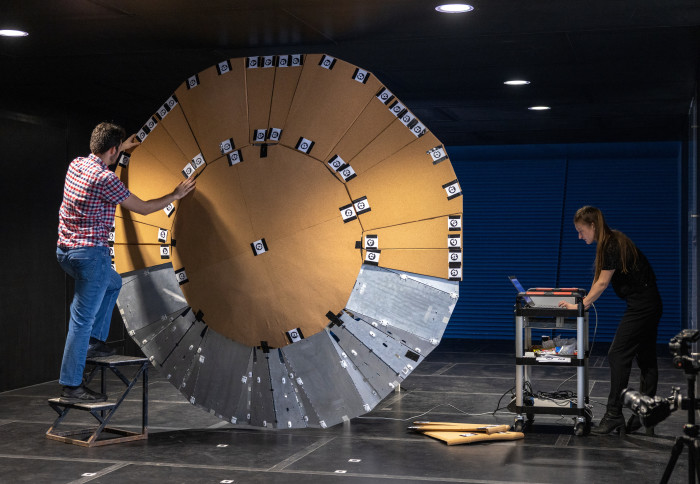

A team of researchers have designed and built a deployable origami-inspired heat shield for Mars atmospheric entry.
The Aeronautics research team, led by Dr Paul Bruce and Dr Matthew Santer, have constructed a novel origami-like structure that will act to protect space vehicles from the intense heat of entry into Mars’ atmosphere.
The shield follows origami principles, with the ability to be stowed away on launch, deployed in space and retracted, if needed.
Heat shields are essential during space missions as they act to reflect and absorb excessive heat produced from forces as the spacecraft enters into the first 100km of a planet’s atmosphere. The shield also aids in slowing down the vehicle for a smooth landing.
Conventional heat shields are often of rigid-fixed geometry with size being constrained by launch vehicles and payload. This has limited the opportunity for larger robotic systems and humans to explore Mars, as they require larger shields.
João Matias, a final year Aeronautics student, highlights the need for such research: “Developing larger heatshields has two distinct benefits: it can ameliorate the conditions experienced by current vehicles, reducing material and structural constraints on their design and allows for heavier payloads, therefore increasing the capability of future Mars missions.”
Origami-like structure
In designing this new type of heat shield, the team opted for a faceted structure using rigid thermal protection system panels fitted between retractable ribs.
The deployable ribs are controlled by stepper motors which allow the heatshield panels to be deployed and stowed without human input. This provides an opportunity for a reusable design, and is also crucial for reliable and repeatable testing of the heat shield’s deployment capabilities.
The unique architecture is key to the folded pattern needed for stowage, allowing a large shield to be compacted into a small volume. The team have undertaken much work to minimise the number of folds and to maximise angles between each fold line in order to ensure aero-thermodynamic success.
Danielle O’Driscoll, a PhD candidate within the team, said: “A few deployable heat shield concepts have been explored over the years, including inflatable and umbrella-like designs that may deform in the high-load environment of atmospheric entry.
“What makes our design unique is the use of rigid materials that lock into place when the heat shield is fully deployed. In our case, an aluminium honeycomb layer provides rigidity and an ablative cork composite layer provides thermal protection.”
Certifying design
Tests conducted in the 10x5 wind tunnel, housed in the Department of Aeronautics and part of the National Wind Tunnel Facility, were used to further investigate the efficacy of the geometry.
Flow visualisation, using smoke, allowed the team to identify how air flows around the deployed heatshield, including stagnation points and areas of significant flow deflection. Results from such tests aid in resolving areas of potential localised heating and to ensure aerodynamic stability.
The team used a technique of photogrammetry to examine heatshield dynamics, in ensuring a rigid deployable faceted structure. Using video and motion tracking technology, they were able to assess how individual parts of the heatshield move, vibrate and deform when experiencing various aerodynamic forces.
Drag characterisation was also performed to measure aerodynamic forces, the heatshield experiences, using load cells and strain gauges. The heatshield’s drag coefficient was observed at different yaw angles and wind speeds.
Jonathan Miller, 10x5 Wind Tunnel Engineer, explores the need for such tests: "Using the wind tunnel allows for a close representation of real-world conditions, in a controlled environment. These tests are of great importance as they allow us to gather a large amount of information on the behaviour of the device, in a wide array of operating conditions.”
Prototype success
The heat shield prototype is a successful demonstration of the potential of deployable systems in space.
The team are now planning to expand their technology to related fields, including but not limited to, aero-thermal, hypersonic systems and other deployable structures.
Dr Matthew Santer, co-lead of the research team, said: “We are looking forward to taking this work to a higher technology readiness level and continuing to grow our expertise in hypersonics and entry systems at the forefront of European capability.”
This research project is funded by the President’s Excellence Fund for Frontier Research (EFFR). The excellence awards support research ideas that hold potential of being breakthrough in their field.
Article text (excluding photos or graphics) © Imperial College London.
Photos and graphics subject to third party copyright used with permission or © Imperial College London.
Reporter

Ayesha Khan
Department of Aeronautics



